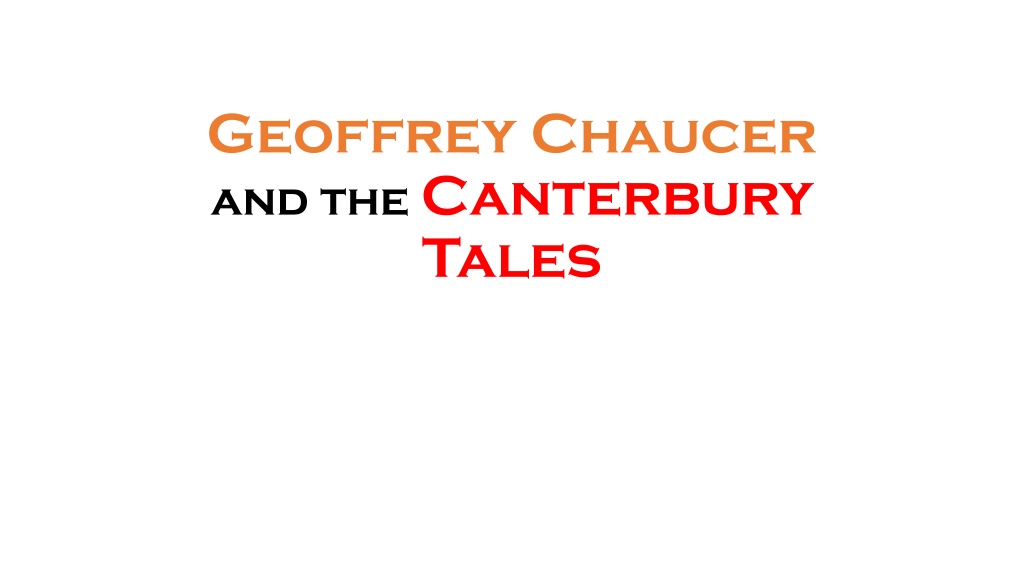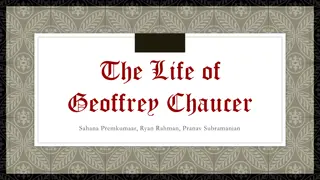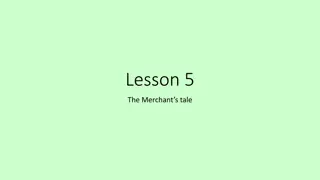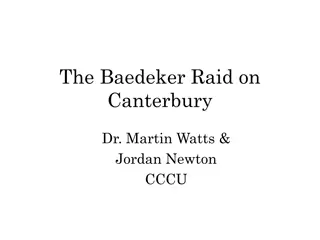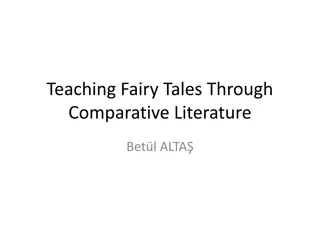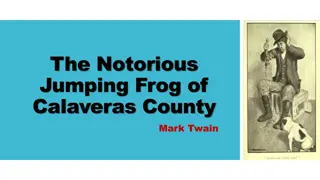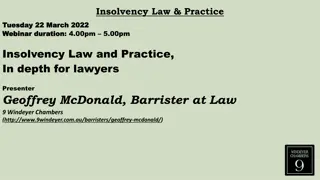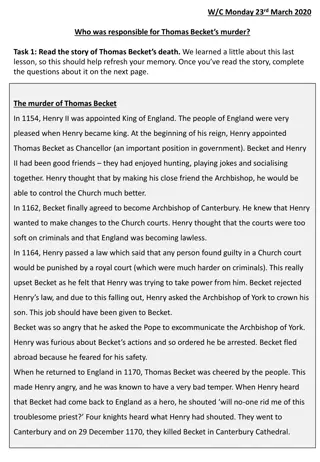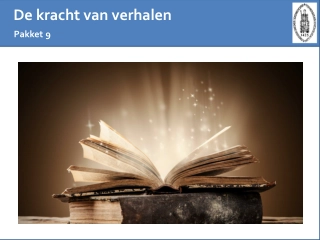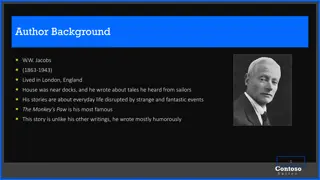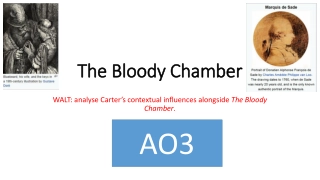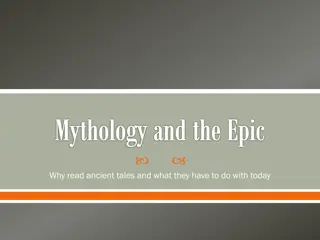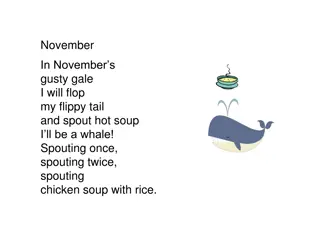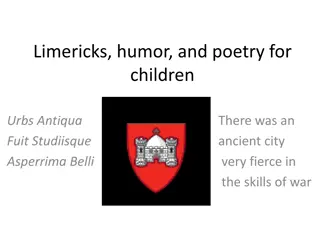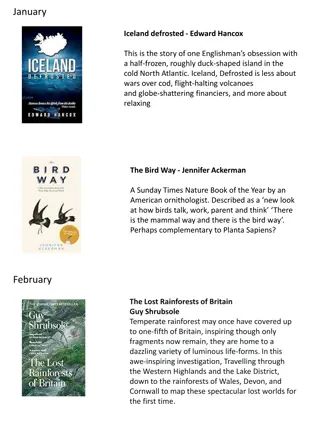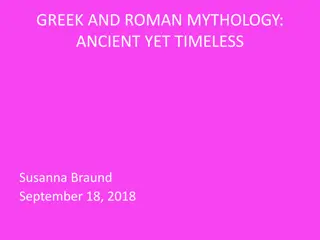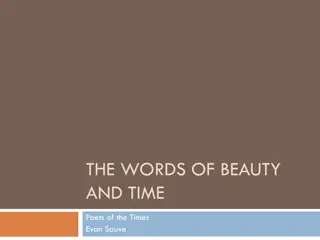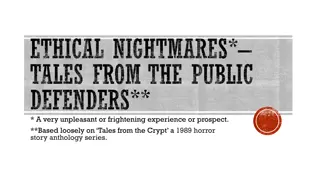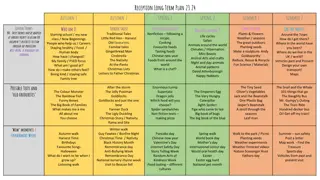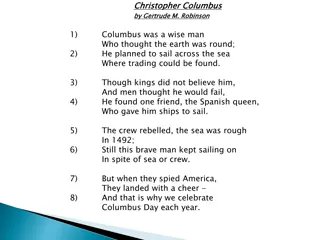Geoffrey Chaucer and The Canterbury Tales: An Overview
Geoffrey Chaucer, born in London in 1343, was a prominent English poet known for his work "The Canterbury Tales". His literary production was influenced by French and Italian works. "The Canterbury Tales" follows a group of pilgrims on a journey, showcasing various themes like love, marriage, corruption, and chivalry. The structure of the tales is inspired by Boccaccio's Decameron, featuring stories within a story. Chaucer's diverse characters reflect both stereotypes and individuality, setting his work apart in English literature.
Uploaded on Jul 15, 2024 | 0 Views
Download Presentation

Please find below an Image/Link to download the presentation.
The content on the website is provided AS IS for your information and personal use only. It may not be sold, licensed, or shared on other websites without obtaining consent from the author. Download presentation by click this link. If you encounter any issues during the download, it is possible that the publisher has removed the file from their server.
E N D
Presentation Transcript
Geoffrey Chaucer and the Canterbury Tales
Chaucers life Geoffrey Chaucer was born in London in 1343, and he was a son of a wine merchant. In 1357 he became a public servant to the Countess Elizabeth of Ulster and in 1359 he fought in the Hundred Years' War. Then, he was employed on important diplomatic missions and in 1366 married Philippa Roet. In 1372 he was sent to Italy where he probably met Petrarch and became familiar with the works of Boccaccio and Dante, in fact Italian literature influenced his works. He also represented the county of Kent in Parliament from 1386 and died in London in 1400.
Literary production Chaucer's literary production is divided into three periods: 1) the French period, when he did some translations influenced by the French models, for example The Romaunt of the Rose (from the French Le roman de la rose) and The Book of the Duchess. 2) the Italian period, when he followed the examples of Boccaccio and Dante (his "House of Fame" is similar to the "Divine Comedy"). Other works are The Parlement of Foules (a fable with animals as characters), Troilus and Criseyde , and 3) the English period, when he wrote The Canterbury tales. He originally planned to write 120 tales (4 per each character) but he died, so he could only write 24 tales. Anyway, this work is considered one of the best of English literature. The Legend of Good Women .
The Canterbury Tales The story is about a group of 30 pilgrims (including G. Chaucer himself) who meet and travel together to Canterbury to visit the shrine of Thomas Becket. In the General Prologue ( v. materiale di approfondimento) the narrator gives a description of each pilgrim. The characters meet at the Tabard Inn; the host of the tavern proposes a tale-telling competition during the journey: each pilgrim has to tell two stories on the way to Canterbury and two stories on the way back (total: 120 stories). The pilgrims come from different classes: knights, clergy, middle classes and trades. The journey starts at the Tabard Inn in London and goes towards Canterbury Cathedral it represents a purification.
The structure The structure is inspired to Boccaccio s Decameron. It is called Chinese box structure because it is similar to a box containing other little boxes: there are stories inside a story. In fact, there is a general story, called the frame (the story of the pilgrims in journey to Canterbury who decide to do a competition). It is mainly represented by the General Prologue. Then, there are all the stories told by the single characters ( they are 24!) Before each story, there is a short introduction in which the narrator goes back to the main frame and each character is shortly introduced.
Themes and style The main themes of the tales are: love, marriage, corruption, hypocrisy and chivalry (from different points of view) The pilgrims appear both as "types" and both as vital individuals. In this, they are different from characters in epic poetry or morality plays who are generally static. They are also portrayed physically (clothes, accessories ) The narrator provides a commentary on the pilgrims with a subtle irony, but at the same time, they have their own voices. It is like the writer disappears, leaving the character speak. This quality makes Chaucer the first great writer in English.
The General Prologue: extract The extract starts with the description of the context: it is April, there are sweet rains and winds but the sun shines and the birds sing. It s the month when people go on pilgrimage and people from all England goes to Canterbury to visit Thomas Becket s tomb. G. Chaucer introduces himself as a poet and a storyteller: it s a first person narrator and one of the pilgrimages. One day, he was in London at the Tabard Inn when 29 people directed to Canterbury arrive. It was a mix of men and women from all social classes. Then, Chaucer describes them
The Knight and the Squire The Knight loved chivalry, truth and honour. He had fought in Egypt, Germany, Russia, Spain, Turkey etc. He was brave and famous, but he was also modest and polite: he was a perfect knight. He had a fine horse, but his horse was tired because they had just been to war. The Squire was the Knight s son. He was about 20 years old, with curly hair and a handsome face. He wore beautiful red and white clothes: he looked like a field of flowers. He had fought for the love of his lady ( courtly love). He could also write songs and poems, draw and dance. He was always singing and whistling and was always happy.
The Nun and the Friar The Nun was a Prioress. Her name was Madam Eglantine. She spoke French well but with an English accent, and had very good manners. When she was eating, she didn t make a mess. She was very sensitive and she cried if she saw a mouse in a trap. She loved dogs and gave them bread, milk and meat. If a dog died, she cried a lot. She had grey eyes, soft red lips and a broad forehead. Her clothes were the latest fashion: she wore an elegant cloak, some bracelets, beads and a golden brooch with an A and the writing Amor vincit omnia ( Love conquers all in Latin). The Friar loved the company of pretty girls. He lived of begging, but he had good social skills and spoke well to people, so he was never short of money. He was a good musician and knew all the inns in all the towns.
The Wife of Bath She was a big woman, with a red face and a gap between her front teeth. She wore a big hat and a large coat on her wide hips. She was a respectable woman; she had been married 5 times and she had had some love stories when she was young. She had been on many pilgrimages: Jerusalem three times, Santiago de Compostela, Boulogne, Cologne etc. She liked talking about love and she knew a lot about it. You needed to speak loud because she was a bit deaf.
The Summoner and the Pardoner The Summoner had a red face and black eyebrows and children were afraid of him. He stank of garlic and onions, which he loved. His role was to make sure that people respected the laws of the Church, but in reality he took bribes and didn t respect the laws. The Pardoner had long, greasy, yellow hair, that was similar to rats tails; his skin looked unnaturally smooth. He had a bag full of pieces of wood, cloth and bones and he said they were a Saint s relics (rests). So he earned more than the honest parson earned in 2 months. Corruption of the Church!
